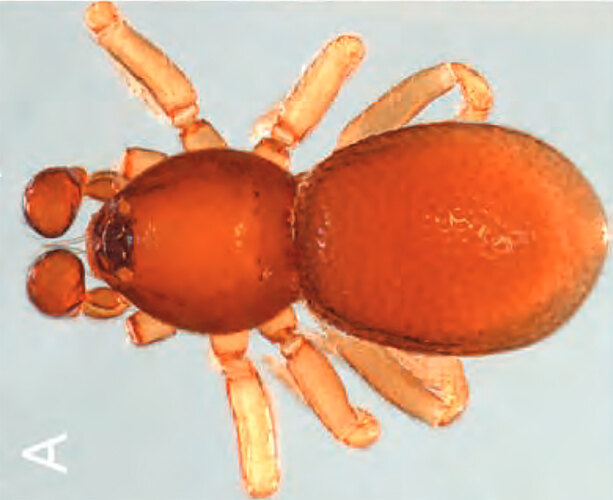Rugose Goblin Spider Opopaea rugosa Baehr & Ott, 2013
Fauna Portal species: 252Diagnosis
(after Baehr et al. 2013): Males of Opopaea rugosa resemble those of O. julianneae in general body shape and postepigastric scutum with longitudinal elevated ridge, covered with a line of slim plumose setae between lateral apodemes, but can be easily recognised by the high shouldered carapace, scuto-pedicel region more than diameter of pedicel, paired scutal ridges not connected and bulb ventrally strongly bulging, tip with ventral crest and deep prolateral incision, ‘fenestra’ large. Females can be separated from all other WA species by the globular appendix (GAp) having a long narrow extension.
Within the context of the oonopid fauna of Barrow Island, O. rugosa is most similar to O. robusta due to the rounded abdomen, but the abdomen is more rugose.
Status
- native
Linnean Holotype
Australia
- Western Australia
Fauna Portal Records
The map shows all records that have been verified as part of the Fauna Portal project and may not represent the true distribution of a species. Specifically, for described species, check the link to the Atlas of Living Australia on this page for potential wider distributions. Fauna Portal Reference specimens and Linnean types are shown in red. If you identified a specimen that exceeds the distribution of an undescribed species as illustrated here, please contact the Fauna Portal team who can assist with the lodgement of the specimen in a public institution and display on the map.
Publications
Baehr BC, Harvey MS, Smith HM, Ott R (2013): The goblin spider genus Opopaea in Australia and the Pacific islands (Araneae: Oonopidae). Memoirs of the Queensland Museum - Nature. 58: 107 - 338
Araneae (Spiders)
- Actinopodidae
- Anamidae
- Araneae fam. indet.
- Araneidae
- Archaeidae
- Argyronetidae
- Arkyidae
- Barychelidae
- Cheiracanthiidae
- Clubionidae
- Corinnidae
- Cycloctenidae
- Deinopidae
- Desidae
- Dictynidae
- Filistatidae
- Gnaphosidae
- Halonoproctidae
- Hersiliidae
- Idiopidae
- Lamponidae
- Linyphiidae
- Lycosidae
- Mimetidae
- Miturgidae
- Mysmenidae
- Nicodamidae
- Oecobiidae
- Oonopidae
- Oxyopidae
- Philodromidae
- Pholcidae
- Pisauridae
- Prodidomidae
- Salticidae
- Scytodidae
- Segestriidae
- Selenopidae
- Sparassidae
- Symphytognathidae
- Tetrablemmidae
- Tetragnathidae
- Theridiidae
- Thomisidae
- Trachelidae
- Trachycosmidae
- Trochanteriidae
- Uloboridae
- Zodariidae
- Zoropsidae
All classes
- Arachnida
- Crustacea
- Entognatha
- Gastropoda
- Insecta
- Orthoptera - Caelifera (Grasshoppers)
- Hymenoptera excl. Formicidae (bees and wasps)
- Blattodea s. str. (Cockroaches)
- Coleoptera (Beetles)
- Dermaptera (earwigs)
- Diptera (flies, mosquitos)
- Entomobryomorpha (slender springtails)
- Hemiptera - Heteroptera (True Bugs)
- Hemiptera - Sternorrhyncha (aphids, scales etc.)
- Hemiptera - Auchenorrhyncha (cicadas, planthoppers)
- Hymenoptera - Formicidae (Ants)
- Trichoptera (Caddisflies)
- Zygentoma (silverfish)
- Myriapoda

